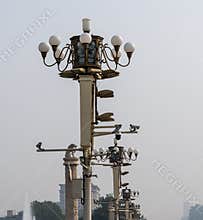Ť©Å®‰É—¨Åœ—ĺ¬Æ•…Å®«Åÿžé—¨Ã€Ä¸å›½Å›½Å®¶È±¡Å¾Ã€‚Tiananmen Square, The Forbidden City Gate Of Beijing, The National Symbol Of Ch. Ť©Å®‰É—¨Æ˜¯æ˜žæ¸…ĸ¤Ä»£Åœ—ĺ¬Çš‡Åÿžçš„ƣɗ¨Ï¼Œå§‹Å»ºäºžæ˜žæœÆ°¸Ä¹Å唏´Ï¼ˆ1417Ź´Ï¼‰Ï¼Œæœ€ÅˆÅ€Œæ‰¿Å¤©É—¨Â€Ï¼Œå¯“€Œæ‰¿Å¤©Å¯È¿Ã€Å—Å‘½Äºžå¤©Â€Ä¹‹Æ„À‚È®¾È®¡È€…ĸºæ˜žä»£Å¾¡Ç”¨Å»ºç‘åœ Å¸ˆè’¯ç¥¥Ã€‚Ƹ…Ɯɡºæ²»Å…«Å¹´Ï¼ˆ1651Ź´Ï¼‰Æ›´Åĸºå¤©Å®‰É—¨Ã€‚Ç”±Åÿžå°Å’œåÿžæ¥¼Ä¸¤Éƒ¨åˆ†Ç»„ƈϼŒæœ‰Æ±‰Ç™½Çž‰Çÿ³Çš„É¡»Å¼¥Åº§Ï¼Œæ€»É«˜34.7DZ³Ã€‚Ť©Å®‰É—¨Åÿžæ¥¼É•¿66DZ³Ã€Å®½37DZ³Ã€‚Åÿžå°Ä¸‹Æœ‰Åˆ¸é—¨Äº”ɘ™Ï¼Œä¸é—´Çš„ň¸é—¨Æœ€Å¤§Ï¼Œä½Äºžåœ—ĺ¬Çš‡Åÿžä¸è½´Çº¿Ä¸šï¼Œè¿‡Åž»Åªæœ‰Çš‡Å¸Æ‰Å¯Ä»¥Ç”±Æ¤Å‡ºå…¥Ã€‚ƣĸ门ƴžä¸šæ–¹Æ‚¬Æœ‚ǀƯ›Æ³½Ä¸œç”»ÅƒÏ¼Œä¸¤È¾¹Åˆ†Åˆ«Æ˜¯â€Œä¸åŽäººæ°‘Å…±Å’œå›½Ä¸‡Å²Â€Å’œâ€Œä¸–Ç•Œäººæ°‘Ť§Å›¢Ç»“ĸ‡Å²Â€Çš„Ť§Å¹…Æ ‡È¯ã€‚Tiananmen Square In China Was The Main Entrance Of The Imperial City Of The Ming And Qing Dynasties. It Was Built In The Fifteenth Year Of Yongle In The Ming Dynasty 1417. It Was Originally Named €Œchengtianmen†And It Was Meant To Be €Œcontained By Heaven And Ordered By Heavenâ€. The Designer Is Yu Ming, A Master Architect Of The Ming Dynasty. In The Eighth Year Of Shunzhi In The Qing Dynasty 1651, It Was Renamed Tiananmen. It Consists Of Two Parts, The City Platform And The City Tower. There Is A White Marble Jade Stone, With A Total Height Of 34.7 Meters. The Tiananmen Gate Is 66 Meters Long And 37 Meters Wide. There Are Five Voucher Gates Under The City Platform. The Ticket Door In The Middle Is The Largest. It Is Located On The Central Axis Of Beijing Imperial City. In The Past, Only The Emperor Could Enter And Exit. Mao Zedong`s Portrait Is Hung Above The Middle Gate, And The Two Sides Are The Slogans Of `Long Live The People`s Republic Of China` And `Long Live The Great Unity Of The People Of The World.`
ID 46525385375 © Wyyx10010 | Megapixl.com
Sharing is not just caring, it's also about giving credit - add this image to your page and give credit to the talented photographer who captured it.:
KEYWORDS
100 105 1417 15000 also area arrival bang beach beijing built calcified called chengtianmen china city dam dynasties dynasty emit fifteenth flood forbidden formed gate group guizhou high huangguoshu huge hum imperial implies length located main means melting meters ming museum named national originally palace phenomenon pond pool province qing qiyun slope special square steep symbol tian top upstream waterfall wide widest will year yongle ayen acopy abrvbar acurren afrac12 aacurren aordm asect aiexcl acedil aabrvbar asup1 1417ayen aayen eayen auml ntiananmen copy areg euml aaordm laquo aeuml shy para eplusmn iexcl afrac34 tiananmen aemacr aeaecedil curren araquo pound cacaeshy ordm aeaeaedeg cedil acute 1417asup1 aeaaaeiquest amacr aeiquest eiquest aafrac12 aeereg frac34 ereg aearaquo cuml cshy anbsp emacr cyen yen aecedil aesup2 raquo 1651asup1 aeacute aacedil cplusmn aadeg aaaeyen frac14 acraquo aeaeaeplusmn cfrac12 ccsup3 ceiexcl afrac14 sect aeraquo elaquo 347cplusmn sup3 aaeyen 66cplusmn frac12 37cplusmn aeacedil eacedil eacute cacedil aeacurren caacedil efrac12 cordm iquest aordf aecacedil aeamacr aeshy aesup1 aenot aecaemacr aesup3 craquo efrac34 sup1 aalaquo aedeg asup2 caordm acent cacurren





































































